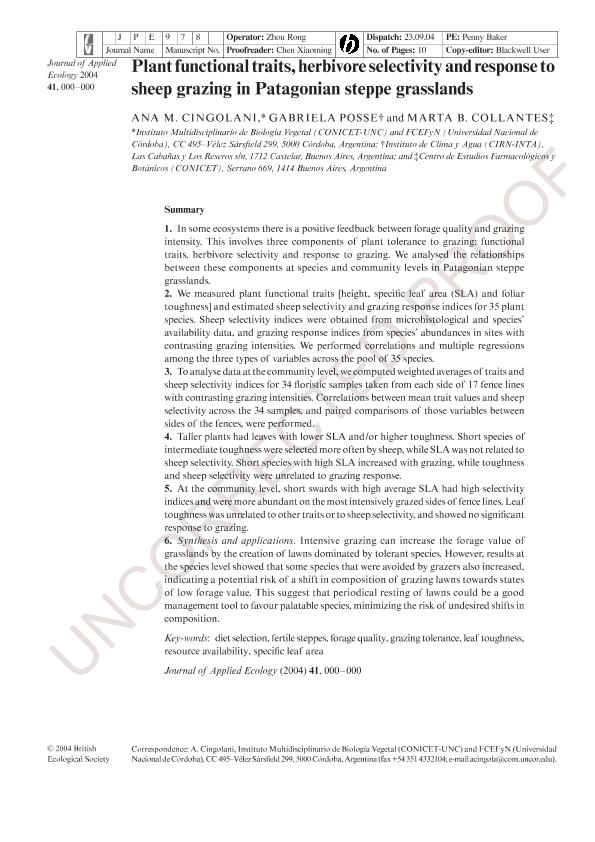Artículo
Plant functional traits, herbivore selectivity and response to sheep grazing in Patagonian steppe grasslands
Fecha de publicación:
02/2005
Editorial:
Wiley Blackwell Publishing, Inc
Revista:
Journal of Applied Ecology
ISSN:
0021-8901
e-ISSN:
1365-2664
Idioma:
Inglés
Tipo de recurso:
Artículo publicado
Clasificación temática:
Resumen
1. In some ecosystems there is a positive feedback between forage quality and grazing intensity. This involves three components of plant tolerance to grazing: functional traits, herbivore selectivity and response to grazing. We analysed the relationships between these components at species and community levels in Patagonian steppe
grasslands.
2. We measured plant functional traits [height, specific leaf area (SLA) and foliar
toughness] and estimated sheep selectivity and grazing response indices for 35 plant species. Sheep selectivity indices were obtained from microhistological and species availability data, and grazing response indices from species abundances in sites with contrasting grazing intensities. We performed correlations and multiple regressions among the three types of variables across the pool of 35 species.
3. To analyse data at the community level, we computed weighted averages of traits and sheep selectivity indices for 34 floristic samples taken from each side of 17 fence lines with contrasting grazing intensities. Correlations between mean trait values and sheep selectivity across the 34 samples, and paired comparisons of those variables between sides of the fences, were performed.
4. Taller plants had leaves with lower SLA and/or higher toughness. Short species of
intermediate toughness were selected more often by sheep, while SLA was not related to sheep selectivity. Short species with high SLA increased with grazing, while toughness and sheep selectivity were unrelated to grazing response.
5. At the community level, short swards with high average SLA had high selectivity
indices and were more abundant on the most intensively grazed sides of fence lines. Leaf toughness was unrelated to other traits or to sheep selectivity, and showed no significant response to grazing.
6. Synthesis and applications. Intensive grazing can increase the forage value of
grasslands by the creation of lawns dominated by tolerant species. However, results
from this study showed that some plant species that were avoided by grazers also
increased, indicating a potential risk of a shift in composition of grazing lawns
towards states of low forage value. This suggests that periodic resting of lawns could
be a good management strategy to favour palatable species, thereby minimizing the risk of undesirable shifts in the overall species composition.
Palabras clave:
Diet Selection
,
Fertile Steppes
,
Specific Leaf Area
Archivos asociados
Licencia
Identificadores
Colecciones
Articulos(IMBIV)
Articulos de INST.MULTIDISCIPL.DE BIOLOGIA VEGETAL (P)
Articulos de INST.MULTIDISCIPL.DE BIOLOGIA VEGETAL (P)
Citación
Collantes, Marta Beatriz; Posse Beaulieu, Gabriela; Cingolani, Ana María; Plant functional traits, herbivore selectivity and response to sheep grazing in Patagonian steppe grasslands; Wiley Blackwell Publishing, Inc; Journal of Applied Ecology; 42; 1; 2-2005; 50-59
Compartir
Altmétricas




